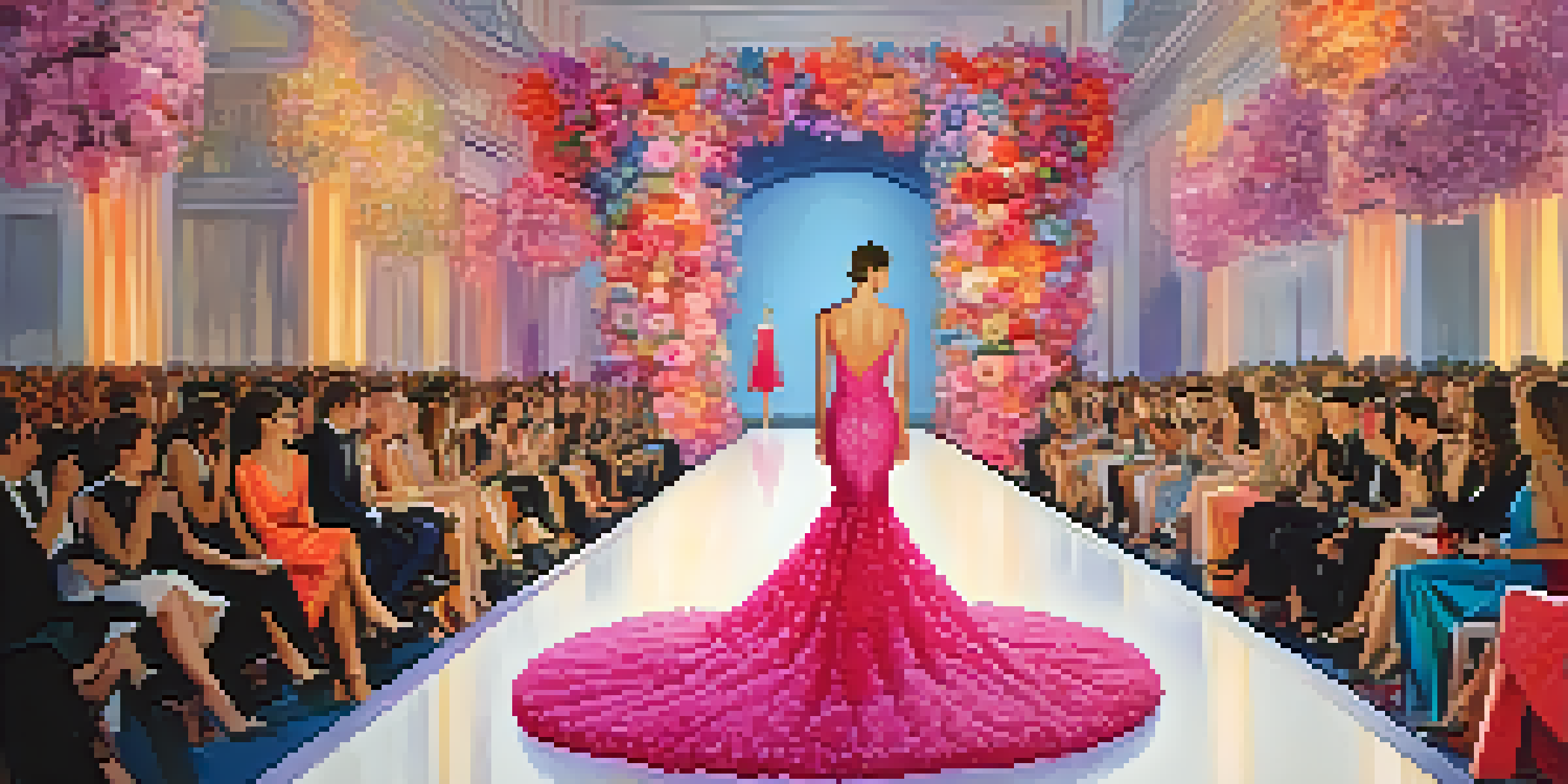The Evolution of PR Tactics in the Fashion Industry Landscape

The Birth of Fashion PR: Setting the Stage
The concept of public relations in fashion emerged in the early 20th century, largely shaped by the need for designers to gain visibility. Designers like Charles Frederick Worth, often referred to as the father of haute couture, understood the importance of presenting their creations to the public. This period marked the beginning of fashion shows and press events, where media and influencers were invited to witness the latest collections.
Fashion is the armor to survive the reality of everyday life.
As the industry began to understand the value of storytelling, fashion PR evolved from mere promotion to creating a narrative around a brand. This storytelling approach helped establish emotional connections between consumers and designers. It wasn’t just about the clothes anymore; it became about the experience and the lifestyle that came with wearing them.
The foundation laid during this period set the stage for more sophisticated PR strategies. With the rise of fashion magazines and influential editors, the landscape of fashion PR began to shift towards a more collaborative model, where designers and media worked hand in hand to shape perceptions.
The Impact of Celebrity Culture on Fashion PR
The 1960s and 70s saw the rise of celebrity culture, which significantly influenced fashion PR tactics. Designers began to recognize the power of celebrity endorsements and collaborations. By dressing high-profile personalities, brands were able to gain instant credibility and visibility, reaching wider audiences through the glamour associated with these stars.

This shift also marked a transition towards a more aspirational marketing approach. Brands started crafting images and narratives around celebrities, showcasing how their designs could elevate one's lifestyle. This tactic proved to be incredibly effective, as fans sought to emulate their favorite stars, driving sales and brand loyalty.
Evolution of Fashion PR Strategies
Fashion PR has transformed from traditional promotion to a nuanced storytelling approach that builds emotional connections with consumers.
In this era, the relationship between fashion and celebrity became symbiotic. Designers gained exposure, while celebrities enjoyed unique pieces that set them apart, leading to a cycle of mutual benefit that continues to thrive today.
Digital Revolution: The New Age of Fashion PR
The advent of the internet in the late 1990s and early 2000s revolutionized the fashion landscape, transforming PR strategies immensely. With the rise of social media platforms like Instagram and Twitter, brands could engage with consumers directly, bypassing traditional media outlets. This democratization of fashion allowed for real-time interaction and feedback, reshaping how PR campaigns were designed.
In the world of fashion, there is no such thing as a permanent trend.
Influencer marketing emerged as a key tactic during this digital shift. Brands began collaborating with social media influencers who had amassed large followings, leveraging their reach to connect with niche audiences. This strategy proved particularly effective for targeting younger demographics who often trust these influencers more than traditional advertising.
Moreover, fashion brands started to embrace user-generated content, encouraging customers to share their experiences online. This created a community-driven approach to PR, where the voice of the consumer became central to brand narratives. The focus shifted from curated messages to authentic storytelling, fostering deeper connections with audiences.
Sustainability and Ethical Fashion: A New Narrative
As consumer awareness around sustainability grew, fashion PR evolved to incorporate these values into brand messaging. Today, many brands are prioritizing ethical practices and transparency, and PR strategies reflect this shift. Campaigns now often highlight sustainable practices, fair labor conditions, and eco-friendly materials, appealing to the environmentally conscious consumer.
This change has prompted brands to not only promote their products but also educate their audience on the importance of sustainability in fashion. By sharing stories about sourcing, production processes, and the impact of consumer choices, brands are fostering a more informed customer base. This approach builds trust and loyalty, as consumers feel more aligned with a brand's mission.
Influence of Celebrities and Data
The rise of celebrity culture and data analytics has reshaped PR tactics, allowing brands to leverage endorsements and tailor campaigns to consumer preferences.
Incorporating sustainability into PR strategies not only enhances brand reputation but also drives meaningful engagement. As consumers increasingly seek out brands that align with their values, fashion PR must continue evolving to reflect this growing demand for integrity and responsibility.
The Role of Data in Shaping Fashion PR Strategies
In the modern era, data analytics has become a cornerstone of effective fashion PR strategies. Brands now use data to understand consumer behavior, preferences, and trends, allowing for more targeted and personalized campaigns. This shift towards data-driven decision-making helps brands allocate resources more efficiently and maximize their impact.
By analyzing metrics from social media engagement, website traffic, and sales, fashion brands can tailor their PR efforts to resonate with their audience. For example, if data shows that a particular influencer drives high engagement, brands may choose to invest more in partnerships with them. This approach not only enhances brand visibility but also ensures that resources are being used effectively.
Moreover, data allows for real-time adjustments to PR campaigns. Brands can monitor the success of their strategies and pivot quickly in response to audience reactions. This agility is crucial in the fast-paced fashion industry, where trends can shift overnight, making data an invaluable tool for staying relevant.
The Future of Fashion PR: Trends to Watch
As we look ahead, the future of fashion PR is poised for even more transformation. Emerging technologies like virtual reality (VR) and augmented reality (AR) are set to change how brands engage with consumers. Imagine being able to try on clothes virtually or attend a fashion show from the comfort of your home; these experiences will likely become more commonplace.
Additionally, the rise of artificial intelligence (AI) in marketing will further refine PR strategies. AI can analyze vast amounts of data to predict trends, optimize campaigns, and even create content. This technology could streamline processes and enhance personalization, allowing brands to connect with consumers on a deeper level.
Focus on Sustainability and Ethics
As consumers demand transparency and ethical practices, fashion PR increasingly incorporates sustainability into brand narratives to build trust and loyalty.
Furthermore, as social justice movements continue to gain momentum, brands will need to align their PR strategies with authenticity and inclusivity. Consumers are increasingly holding brands accountable for their social responsibility, and those that fail to adapt may find themselves left behind. The future of fashion PR will undoubtedly be shaped by these evolving consumer expectations.
Conclusion: Embracing Change in Fashion PR
The evolution of PR tactics in the fashion industry reflects broader societal changes and technological advancements. From the early days of exclusive fashion shows to the current digital landscape, the industry has continually adapted to meet the demands of consumers. This adaptability is essential for brands looking to thrive in an ever-changing environment.
As we move forward, the focus on sustainability, data-driven strategies, and innovation will play a crucial role in shaping the future of fashion PR. By embracing these changes, brands can forge deeper connections with their audiences and remain relevant in a competitive market. The key will be to balance authenticity with creativity while staying responsive to consumer needs.

Ultimately, the journey of fashion PR is ongoing, and those who are willing to evolve will lead the way in creating meaningful narratives that resonate with consumers. As the landscape shifts, the potential for captivating storytelling and impactful engagement remains limitless.